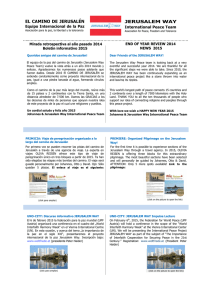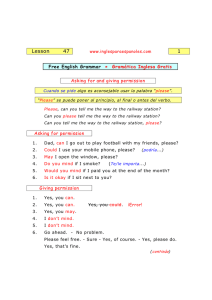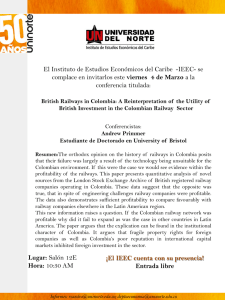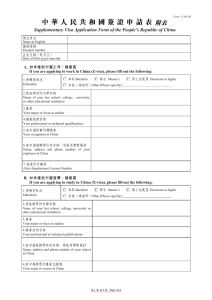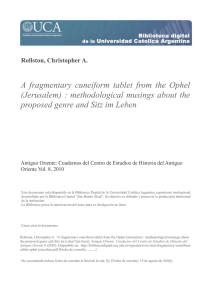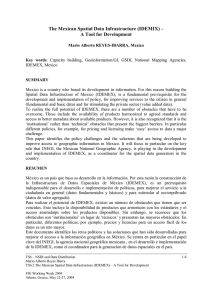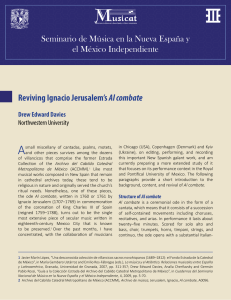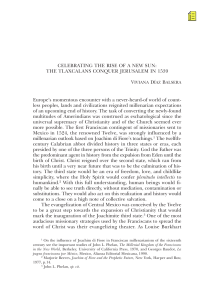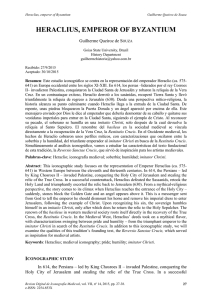Jerusalem light rail, an international humanitarian law (IHL)
Anuncio
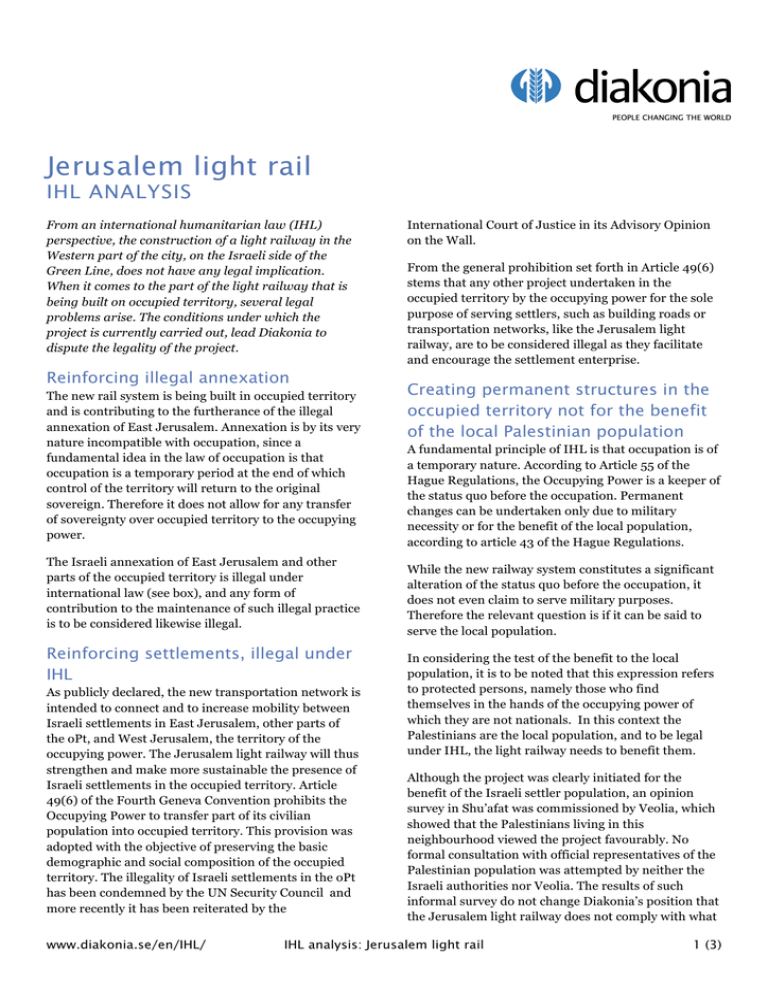
Jerusalem light rail IHL ANALYSIS From an international humanitarian law (IHL) perspective, the construction of a light railway in the Western part of the city, on the Israeli side of the Green Line, does not have any legal implication. When it comes to the part of the light railway that is being built on occupied territory, several legal problems arise. The conditions under which the project is currently carried out, lead Diakonia to dispute the legality of the project. Reinforcing illegal annexation The new rail system is being built in occupied territory and is contributing to the furtherance of the illegal annexation of East Jerusalem. Annexation is by its very nature incompatible with occupation, since a fundamental idea in the law of occupation is that occupation is a temporary period at the end of which control of the territory will return to the original sovereign. Therefore it does not allow for any transfer of sovereignty over occupied territory to the occupying power. The Israeli annexation of East Jerusalem and other parts of the occupied territory is illegal under international law (see box), and any form of contribution to the maintenance of such illegal practice is to be considered likewise illegal. Reinforcing settlements, illegal under IHL As publicly declared, the new transportation network is intended to connect and to increase mobility between Israeli settlements in East Jerusalem, other parts of the oPt, and West Jerusalem, the territory of the occupying power. The Jerusalem light railway will thus strengthen and make more sustainable the presence of Israeli settlements in the occupied territory. Article 49(6) of the Fourth Geneva Convention prohibits the Occupying Power to transfer part of its civilian population into occupied territory. This provision was adopted with the objective of preserving the basic demographic and social composition of the occupied territory. The illegality of Israeli settlements in the oPt has been condemned by the UN Security Council and more recently it has been reiterated by the www.diakonia.se/en/IHL/ International Court of Justice in its Advisory Opinion on the Wall. From the general prohibition set forth in Article 49(6) stems that any other project undertaken in the occupied territory by the occupying power for the sole purpose of serving settlers, such as building roads or transportation networks, like the Jerusalem light railway, are to be considered illegal as they facilitate and encourage the settlement enterprise. Creating permanent structures in the occupied territory not for the benefit of the local Palestinian population A fundamental principle of IHL is that occupation is of a temporary nature. According to Article 55 of the Hague Regulations, the Occupying Power is a keeper of the status quo before the occupation. Permanent changes can be undertaken only due to military necessity or for the benefit of the local population, according to article 43 of the Hague Regulations. While the new railway system constitutes a significant alteration of the status quo before the occupation, it does not even claim to serve military purposes. Therefore the relevant question is if it can be said to serve the local population. In considering the test of the benefit to the local population, it is to be noted that this expression refers to protected persons, namely those who find themselves in the hands of the occupying power of which they are not nationals. In this context the Palestinians are the local population, and to be legal under IHL, the light railway needs to benefit them. Although the project was clearly initiated for the benefit of the Israeli settler population, an opinion survey in Shu’afat was commissioned by Veolia, which showed that the Palestinians living in this neighbourhood viewed the project favourably. No formal consultation with official representatives of the Palestinian population was attempted by neither the Israeli authorities nor Veolia. The results of such informal survey do not change Diakonia’s position that the Jerusalem light railway does not comply with what IHL analysis: Jerusalem light rail 1 (3) IHL establishes under Article 43 of the Hague Regulations. First, since the survey was unilaterally undertaken by the rail company contracted to construct the railway its objectivity is disputable. Secondly, the potential incidental benefit for an very limited portion of the Palestinian community, namely those residing in Shu’afat, does not change the illegal nature of the project, which excludes the majority of the local population. Additionally, the fact that despite crossing through parts of the occupied territory, the railway network will serve only one Palestinian neighbourhood demonstrates that the project does not aim to answer the transportation needs of the Palestinians. The new train line will not connect Palestinians of Shu’afat to other Palestinian neighbourhoods of East Jerusalem, whereas it will effectively connect illegal settlements, the primary beneficiaries of the rail service, and make their presence more entrenched and sustainable. In light of the above mentioned facts, the light railway project does not satisfy the test of the benefit to the local population. However, even if this test had been satisfied, the project would still remain problematic in an IHL perspective, due to its relation with other illegal practices, namely the annexation of East Jerusalem and other portions of the oPt as well as the settlements. Ø Ø Read more about article 55 of the Hague Regulations Read more about article 43 of the Hague Regulations Illegal expropriation of private property Most of the construction of the light railway is taking place on existing roads and public areas and it seems that large expropriation of private property was not required. However, at least one case of expropriation of private property has been registered. It should be noted that Article 46 of the Hague Regulations states that private property must be respected and cannot be confiscated. Exceptions to such a prohibition are provided only when such measures are necessary for imperative military reasons or for the benefit of the local population. As discussed above, none of these criteria can be met by the light railway. Supporting illegal discrimination of protected persons The Jerusalem light rail will operate within a discriminatory transportation system: despite crossing through some parts of the oPt, the main purpose of the rail line is to serve the Israeli population and in particular settlers whose presence on occupied territory is illegal under IHL. In the best case scenario, only an limited portion of Palestinian population composed only of Jerusalem ID holders might incidentally benefit from the new train line. Such discriminatory access to the service provided by the new train is contrary to international law and the prohibition against discrimination, a norm of customary international law. The prohibition against discrimination is expressed in the Common Article 3(1) of the Geneva Conventions, Articles 13 and 27 of the Fourth Geneva Convention. Ø Read more about the prohibition against discrimination in IHL Facts and figures Currently, the first phase of the Jerusalem light rail is under construction. The route of the first instalment of the train line will connect the settlements of Neve Ya’aqov and Pisgat Ze’ev, via the East Jerusalem neighbourhood of Shu’afat, to the West Jerusalem city centre and neighbourhoods such as Bet haKerem. The new transportation system is likely to facilitate commuting from settlements north of Jerusalem, as well as from the settlements east of Jerusalem like Ma’aleh Adumim and those in the Jordan Valley. Upon completion of all the eight lines planned for this project, estimated for 2020, the new transportation network will effectively connect the settlements of north Jerusalem with the settlement of Gilo in southern Jerusalem, de facto integrating portions of the occupied territory with the territory of the State of Israel. The only planned stops that would directly serve Palestinians would be located in the area of Shu’afat. Ø To the official site of the project (English) a map of the entire planned light rail system (Hebrew) The term “East Jerusalem” is used for the area between the “Green Line” (the 1948 armistice line) and the www.diakonia.se/en/IHL/ IHL analysis: Jerusalem light rail 2 (3) eastern boundary of the Jerusalem Municipality, unilaterally drawn by Israel, "annexing" the area to Israel. East Jerusalem has, together with the rest of the West Bank, been under Israeli occupation since the 1967 Six-Day War. Annexation by the use of force is contrary to international law. Ø Read more about East Jerusalem Annexation under international law As set forth in Article 2(4) of the UN Charter, annexation by the use or threat of force is prohibited under international law. This principle was restated in GA Resolution 2625 (XXV) of 1970, which noted that states must not use force to violate existing international boundaries or to solve international disputes, including territorial ones. In response to Israel’s self-declared annexation of East Jerusalem, the UN Security Council affirmed that acquisition of territory by annexation is forbidden and that the Israeli law declaring East Jerusalem annexed therefore is null and void. Similar considerations were voiced by the International Court of Justice (ICJ) in its Advisory Opinion on the Wall, which stated that Wall built in the West Bank leads to permanent facts on the ground which can result in de facto annexation of territory. The international community, authoritative international judiciary and UN bodies have thus clearly rejected Israel's unilateral annexation. Therefore East Jerusalem remains occupied and a part of the oPt, along with the rest of the West Bank and the Gaza Strip. Ø Ø Read more about annexation To Diakonia's and Amnesty International's (Swedish section) letter about Connex/Veolia Environment www.diakonia.se/en/IHL/ IHL analysis: Jerusalem light rail 3 (3)
